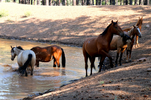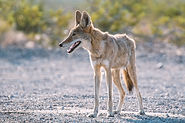Coatimundi
Nasua narica

Look along canyons or riparian areas in warmer months
The coatimundi, often called a coati, is a relative of the raccoon recognized by its long, pointed snout and distinctive ringed tail. These animals are highly social and active, often traveling in groups called bands that may include a dozen or more individuals. Coatis are skilled climbers and foragers, using their flexible noses to search for insects, fruits, small vertebrates, and eggs in the forest floor and trees. In Arizona, they are primarily found in the southern mountains and desert canyons but are considered rare in the north, where sightings occasionally occur in forested canyons. Coatis are diurnal, spending much of the day exploring, climbing, and foraging together, and retreating to trees or rocky ledges at night. Their lively behavior and distinctive appearance make them a fascinating species for wildlife watchers, representing a unique link between Arizona’s deserts and tropical ecosystems farther south.
Mammal

Identification & Behavior
Key Features: Elongated nose, ringed tail, reddish-brown fur
Size: Body 13–27 in; tail 20 in; 7–15 lbs
Behavior: Very social, often forage in groups; excellent climbers
Diet: Omnivorous — fruits, insects, lizards, small vertebrates
Activity Pattern: Diurnal
Habitat & Distribution
Found in southeastern Arizona, primarily in the Santa Rita, Huachuca, and Patagonia Mountains of the Madrean Sky Islands. Inhabits oak and pine-oak woodlands, canyons, and rocky slopes, often near riparian corridors. Present in Coronado National Forest.
Elevation Range: 3,000–7,000 ft
Seasonal Presence: Mostly summer and fall
Risks & Management
Keep food secure; coatis can raid campsites









































